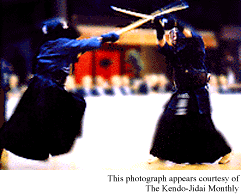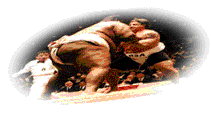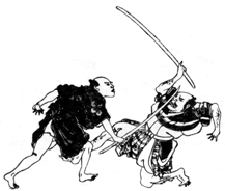Member of Martial-Arts HyperBanner


The following information is a breakdown of several different forms of Japanese Martial Arts or arts that have been based upon their Japanese roots. Some of these particular styles I have used and incorporated in my personal art of Aesthetic Jeet Kune Do. I have just started this page, so expect more arts to come. Though I prefer Chinese Martial Arts.. I had to pay respect to those arts that share common grounds. I hope you find them of use..
--"Sifu" Bevan Bell

 AIKIDO: The word AIKIDO in Japanese is made up of three characters, called kanji. The first and most important is "AI", which means "to meet, to come together, to harmonize". The second kanji is "KI", which means "energy, spirit, mind". The third and last character is "DO", which means "the way of". When put together these three kanji, "AI-KI-DO", mean "the way of harmonizaing with the spirit of the universe". O'Sensei describes how he chose this name for his martial art:
AIKIDO: The word AIKIDO in Japanese is made up of three characters, called kanji. The first and most important is "AI", which means "to meet, to come together, to harmonize". The second kanji is "KI", which means "energy, spirit, mind". The third and last character is "DO", which means "the way of". When put together these three kanji, "AI-KI-DO", mean "the way of harmonizaing with the spirit of the universe". O'Sensei describes how he chose this name for his martial art:
"One who has gained the secret of Aikido has the universe in himself. He is never defeated, however fast the
enemy may attack. It is not because his technique is faster than that of the enemy. It is not a question of speed or
strength. The fight is over before it is begun."
Aikido practice done correctly is strenuous but not violent, demanding but not rough. Class begins with warm-up exercises and stretches to relax and prepare the body for partner practice. Warm-ups generally end with ukemi (correct falling) including forward and backward rolls. Ukemi permits each student to practice Aikido with confidence and safety. The instructor then starts by demonstrating a technique to be applied against a certain attack. The class divides into pairs, and each partner alternates being uke and nage (attacker and defender). Both partners depend on each other to safely and smoothly complete each technique. In this way confidence and fluid, continuous movement is developed. There should be no struggling or resistance in the encounter. Each partner should become conscious of his/her own level of ability and that of his/her partners and should strive to improve that level with each class. Every class includes several different techniques to give the student an opportunity to look at the attach-defense experience differently. As studens advance, the number of techniques, including practice with wooden sword and staff, and the level of difficulty is increased.
 JUDO: Judo was popularized back in the 1940's and 50's. It was basically an Americanized art due to the fact that America was at war with Japan.. and soon afterwards, Korea. The art of Judo was astounding to the Allied forces simply because it was an effective unarmed combat system. Some of the Americans that witnessed this came back to the states and shared the very small knowlegde of the art to others. The art was then spread among the masses of defense systems around the world. Judo became an even more popular art when it was put into films and used by such characters as James Bond agent 007. The art basically consists of throws and is a system similar to that of Aikido.
JUDO: Judo was popularized back in the 1940's and 50's. It was basically an Americanized art due to the fact that America was at war with Japan.. and soon afterwards, Korea. The art of Judo was astounding to the Allied forces simply because it was an effective unarmed combat system. Some of the Americans that witnessed this came back to the states and shared the very small knowlegde of the art to others. The art was then spread among the masses of defense systems around the world. Judo became an even more popular art when it was put into films and used by such characters as James Bond agent 007. The art basically consists of throws and is a system similar to that of Aikido.
 KENDO: Kendo is a Japanese martial art which trains the mind and body and cultivates one's character through one-on-one combat using a bamboo sword while wearing traditional clothing and protective equipment. A scoring point is defined as an accurate strike or thrust to a correct area of the opponent's protective equipment using the proper area of the shinai, with high spirit and correct posture, and followed by physical and mental alertness.
KENDO: Kendo is a Japanese martial art which trains the mind and body and cultivates one's character through one-on-one combat using a bamboo sword while wearing traditional clothing and protective equipment. A scoring point is defined as an accurate strike or thrust to a correct area of the opponent's protective equipment using the proper area of the shinai, with high spirit and correct posture, and followed by physical and mental alertness.
Kiai is the vocalization of one's spirit, concentration, and attack. For a strike to be valid, you must call out the name of the point at the same instant it is struck, with spirit and intensity. Another type of kiai is Kakegoe, in which you vocalize your spirit and willingness to do combat against your opponent.
Posture-- In kendo, the normal posture is with the right foot in front, the left heel slightly raised, the body facing squarely to the front, and the back and neck straight. When striking, at the moment of impact the arms should be straight, the hands should be "snapping" the shinai into the point, the foot should be landing, and the body should be straight and "into" the strike.
Zanshin refers to mental and physical alertness, especially after completing an attack.
A scoring point is the combination of ki-ken-tai-ichi, meaning the spirit, sword, and body are one. Before being allowed to wear protective equipment, a beginner spends many months or even years practicing valid strikes from the proper distance to
the various targets.
 DUX RYU NINJITSU:Dux Ryu Ninjitsu's self-defense techniques are geared to the individual, thus the individual progress is faster, finding personal self-defense practical for today's threats and builds around one's own strengths and weaknesses. Another factor, separating Dux Ryu Ninjitsu from traditional Martial Arts, is that training is not addressed to fighting only under ideal conditions like in school, but in fluctuating situations and environments. For example, one v. multiple attackers, fighting in the dark, in a crowd or hallway, on slippery ground, such as wet grass, where a fight strategy emphasizing kicking would be rendered useless.
DUX RYU NINJITSU:Dux Ryu Ninjitsu's self-defense techniques are geared to the individual, thus the individual progress is faster, finding personal self-defense practical for today's threats and builds around one's own strengths and weaknesses. Another factor, separating Dux Ryu Ninjitsu from traditional Martial Arts, is that training is not addressed to fighting only under ideal conditions like in school, but in fluctuating situations and environments. For example, one v. multiple attackers, fighting in the dark, in a crowd or hallway, on slippery ground, such as wet grass, where a fight strategy emphasizing kicking would be rendered useless.
After the student has become proficient in hand to hand, hand to weapon self-defense, he/she is introduced to "Inpo:" the ancient art of escape: climbing, herbology, emergency first aid, acupressure, water safety, outdoor survival skills and a host of other rewarding and enjoyable skills, all of which can be employed in self-defense so that one can go anywhere in the world
and, under the most extreme conditions, survive.
The purpose of Dux Ryu Ninjitsu lies not in victory or defeat but in the perfection of one's character. Dux Ryu Ninjitsu is not
solely self-defense or physical conditioning, but enhances one's self-worth and develops character and maturity. This is instilled
in all students, helping them find self- confidence and discipline, putting them on a pathway to higher achievement outside the "Dojo."
 SUMO: Sumo, the national sport of Japan, has a history of over a thousand years. It has some similarity to boxing and wrestling, and a sport resembling sumo is practiced in the Soviet Union and in North and South Korea. References to it can also be found in Indian and Chinese historical records, and pictures of it can be seen in ancient Greek murals. Ancient history also tells us that the winner in sporting competitions resembling sumo received the highest praise during the festival of the Olympiad. It can therefore be said that sumo was played throughout the world in ancient times, with no regard for differences between East and West.
SUMO: Sumo, the national sport of Japan, has a history of over a thousand years. It has some similarity to boxing and wrestling, and a sport resembling sumo is practiced in the Soviet Union and in North and South Korea. References to it can also be found in Indian and Chinese historical records, and pictures of it can be seen in ancient Greek murals. Ancient history also tells us that the winner in sporting competitions resembling sumo received the highest praise during the festival of the Olympiad. It can therefore be said that sumo was played throughout the world in ancient times, with no regard for differences between East and West.
The specific features of Japanese sumo developed over time in harmony with the climate and natural surroundings of Japan and
the cultural and spiritual characteristics of the Japanese people. The first reference to sumo in Japanese history is to its use in mythological times in a duel. The history of sumo really starts in the 8th century when it was performed for the Emperor at court banquets. From that time on, sumo became one of the regular functions arranged at the annual court banquets, and this tradition continued for some 400 years.
 IAI-DO: Iaido (ee-eye-doe), a derivative of Japanese Kenjutsu (swordsmanship techniques), is the study of drawing the sword, cutting, and returning it to its scabbard, all with a minimum of exertion. The essence of iaido, a non-combative discipline practiced for the individual's spiritual cultivation, is much different than its forerunner, Iaijutsu. Iaijutsu is a similar art practiced for combative purposes.
IAI-DO: Iaido (ee-eye-doe), a derivative of Japanese Kenjutsu (swordsmanship techniques), is the study of drawing the sword, cutting, and returning it to its scabbard, all with a minimum of exertion. The essence of iaido, a non-combative discipline practiced for the individual's spiritual cultivation, is much different than its forerunner, Iaijutsu. Iaijutsu is a similar art practiced for combative purposes.
Iaido is practiced today as an aid to self-discipline and coordination; many of the actual cutting techniques are valid, but no one seems to be carrying swords very often these days. The physical and mental benefits are available to all practitioners, regardless of their martial arts background.

[Return to Main Page]
[On-Line Kung-Fu Instruction]
[A breakdown of Aesthetic Jeet Kune Do]
[To the Wisdom of Kung-Fu]
[To the Page of Japanese Fighting Arts]
[Back to Page One of Jackie's Filmography]
[To the Bruce Lee Kung-Fu Filmography]
[To Brandon Lee's Filmography]
[To the Picture Archives]
[To the Page of the Etenal Tao]
[To the Page O' Links]
[All About Me]
[Home of THE TARGET]
This page hosted by  Get your own Free Home Page
Get your own Free Home Page